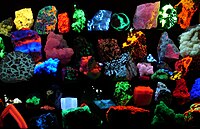
Photo from wikipedia
Small molecules inhibitors of neuraminidases (NAs) are ones of the most prospective molecules proposed for the treatment of influenza viruses. The determination of their inhibition activity in vitro is an… Click to show full abstract
Small molecules inhibitors of neuraminidases (NAs) are ones of the most prospective molecules proposed for the treatment of influenza viruses. The determination of their inhibition activity in vitro is an important step during the development of antiviral drugs. However, the analytical methods typically used for the evaluation of NA activity and inhibition (fluorescence-based assays using MUNANA substrate or thiobarbituric acid assay, TBA) may suffer from interferences caused by tested inhibitors as signal quenching or self-fluorescence, moreover in TBA are used toxic and carcinogenic reagents. The determination of the NA activity can be effectively performed by alternative methods based on lectin - glycan recognition, usually as enzyme-linked lectin assay (ELLA). We have adapted the ELLA assay to a lectin-based assay in a microplate format with fluorescence detection for determination of NA inhibitory activity. We optimized our protocol and the developed method was tested using four different small molecule NA inhibitors or potential NA inhibitors (DANA, zanamivir, quercetin and α-mangostin) with three bacterial NAs (from Clostridium perfringens, Vibrio cholerae and Arthrobacter ureafaciens), and the IC50 values for NA inhibitors were determined. The inhibition effect of DANA was observed for all 3 tested NAs (IC50 = 10.1 µM for V. cholerae, 13.4 µM for C. perfringens and 402.9 µM for A. ureafaciens, respectively) and of Zanamivir only for NA from V. cholerae (IC50 = 101.9 µM). For both quercetin and α-mangostin, no inhibition effect to the tested NAs was observed. The main advantages of herein described method are good sensitivity due to fluorescent signal detection, the absence of the interference caused by fluorescent signal quenching by tested inhibitors, the use of natural substrates (glycoproteins) and the avoiding the use of toxic reagents.
Journal Title: Journal of biotechnology
Year Published: 2020
Link to full text (if available)
Share on Social Media: Sign Up to like & get
recommendations!